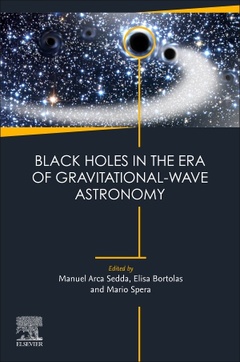Description
Black Holes in the Era of Gravitational-Wave Astronomy
Coordinators: Sedda Manuel Arca, Bortolas Elisa, Spera Mario
Language: English
Subject for Black Holes in the Era of Gravitational-Wave Astronomy:
Publication date: 06-2024
560 p. · 15x22.8 cm · Paperback
560 p. · 15x22.8 cm · Paperback
Description
/li>Contents
/li>Biography
/li>Comment
/li>
Black Holes in the Era of Gravitational-Wave Astronomy provides a multidisciplinary, up-to-date view of the physics of black holes, along with an exhaustive overview of crucial open questions and recent advancements in the astrophysics of black holes in the wake of incredible advancements made in the last decade. It includes discussions on improvements in theoretical modeling and observational perspectives for black holes of all sizes, along with associated challenges. The book's structure and themes will enable an entwined understanding of black hole physics at all scales, thus avoiding the compartmentalized view that is typical of more specialized manuscripts and reviews.
This book is a complete reference for scientists interested in a multidirectional approach to the study of black holes. It provides substantial discussions about the interplay of different types of black holes and gives professionals a heterogeneous and comprehensive overview of the astrophysics of black holes of all masses.
This book is a complete reference for scientists interested in a multidirectional approach to the study of black holes. It provides substantial discussions about the interplay of different types of black holes and gives professionals a heterogeneous and comprehensive overview of the astrophysics of black holes of all masses.
1. Stellar Black Holes and Compact Stellar Remnants
2. Intermediate-mass black holes in Star Clusters and Dwarf Galaxies
3. Supermassive black holes
4. Primordial Black Holes
5. Multi-Messenger Astronomy with Black Holes
2. Intermediate-mass black holes in Star Clusters and Dwarf Galaxies
3. Supermassive black holes
4. Primordial Black Holes
5. Multi-Messenger Astronomy with Black Holes
Manuel Arca Sedda is Assistant Professor at the Gran Sasso Science Institute, Italy. His research focuses mainly on modelling black hole formation in stellar systems and using models to interpret gravitational wave observations. Manuel obtained his PhD in Astronomy in 2014 from the University of Rome Sapienza. In 2017 he joined the Collaborative Research Center SFB881 “The Milky Way System at the University of Heidelberg. In 2018 he was awarded an Alexander von Humboldt fellowship for the research project “Black holes at all the scales, focused on the study of the evolution of black holes from stellar to galactic scales. In 2021 Manuel was awarded a prestigious Marie Curie Sklowdoska Fellowship from the European Union to pursue at the University of Padova his research project "GRACE-BH: Gravitational Radiation from Crowded Environments".
Elisa Bortolas is Postdoctoral researcher at the University of Milano-Bicocca, working in the group led by Alberto Sesana. Her research focuses on the dynamics of supermassive binaries in preparation for the forthcoming low-frequency gravitational wave detectors. Elisa obtained her PhD in Astronomy from the University of Padova, in 2019, in collaboration with the University of Surrey, working on the dynamics of galactic nuclei. Her PhD thesis was awarded the Gratton prize for the best Italian thesis in Astronomy. She then moved to the University of Zurich, working as a postdoc in the group led by L. Mayer, on the dynamics of massive black hole binaries in the early Universe.
Mario Spera is Assistant Professor at the International School for Advanced Studies - SISSA, where he works as a theoretical and computational astrophysicist. The main goal of his research is to provide an astrophysical interpretation to present and forthcoming gravitational-wave detections. Mario obtained his PhD in Astronomy in 2014 from University of Rome - Sapienza. From 2014 to 2017 he was a postdoc at the Astronomical Observatory of Padova, funded
Elisa Bortolas is Postdoctoral researcher at the University of Milano-Bicocca, working in the group led by Alberto Sesana. Her research focuses on the dynamics of supermassive binaries in preparation for the forthcoming low-frequency gravitational wave detectors. Elisa obtained her PhD in Astronomy from the University of Padova, in 2019, in collaboration with the University of Surrey, working on the dynamics of galactic nuclei. Her PhD thesis was awarded the Gratton prize for the best Italian thesis in Astronomy. She then moved to the University of Zurich, working as a postdoc in the group led by L. Mayer, on the dynamics of massive black hole binaries in the early Universe.
Mario Spera is Assistant Professor at the International School for Advanced Studies - SISSA, where he works as a theoretical and computational astrophysicist. The main goal of his research is to provide an astrophysical interpretation to present and forthcoming gravitational-wave detections. Mario obtained his PhD in Astronomy in 2014 from University of Rome - Sapienza. From 2014 to 2017 he was a postdoc at the Astronomical Observatory of Padova, funded
- Focuses on recent advances and future perspectives surrounding black holes, providing researchers with a clear view of cutting-edge research
- Offers readers a multidisciplinary, fresh view on black holes, discussing and reviewing the most recent advancements in theoretical, numerical and observational techniques put in place to detect black holes
- Provides a bridge among different black hole areas, fostering new collaborations among professionals working in different, but intrinsically interconnected fields
© 2024 LAVOISIER S.A.S.

